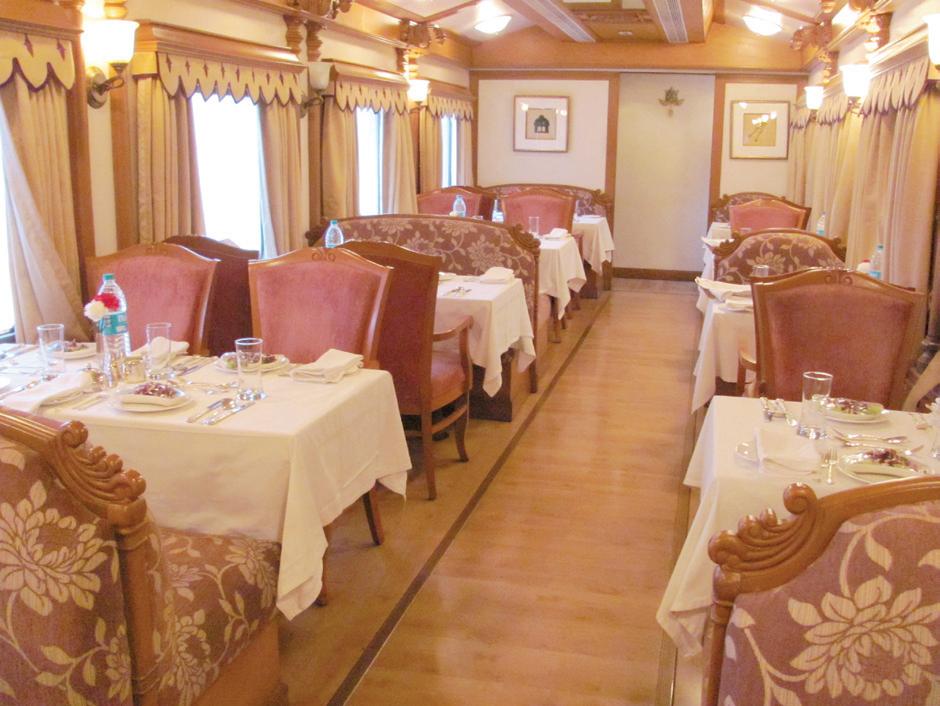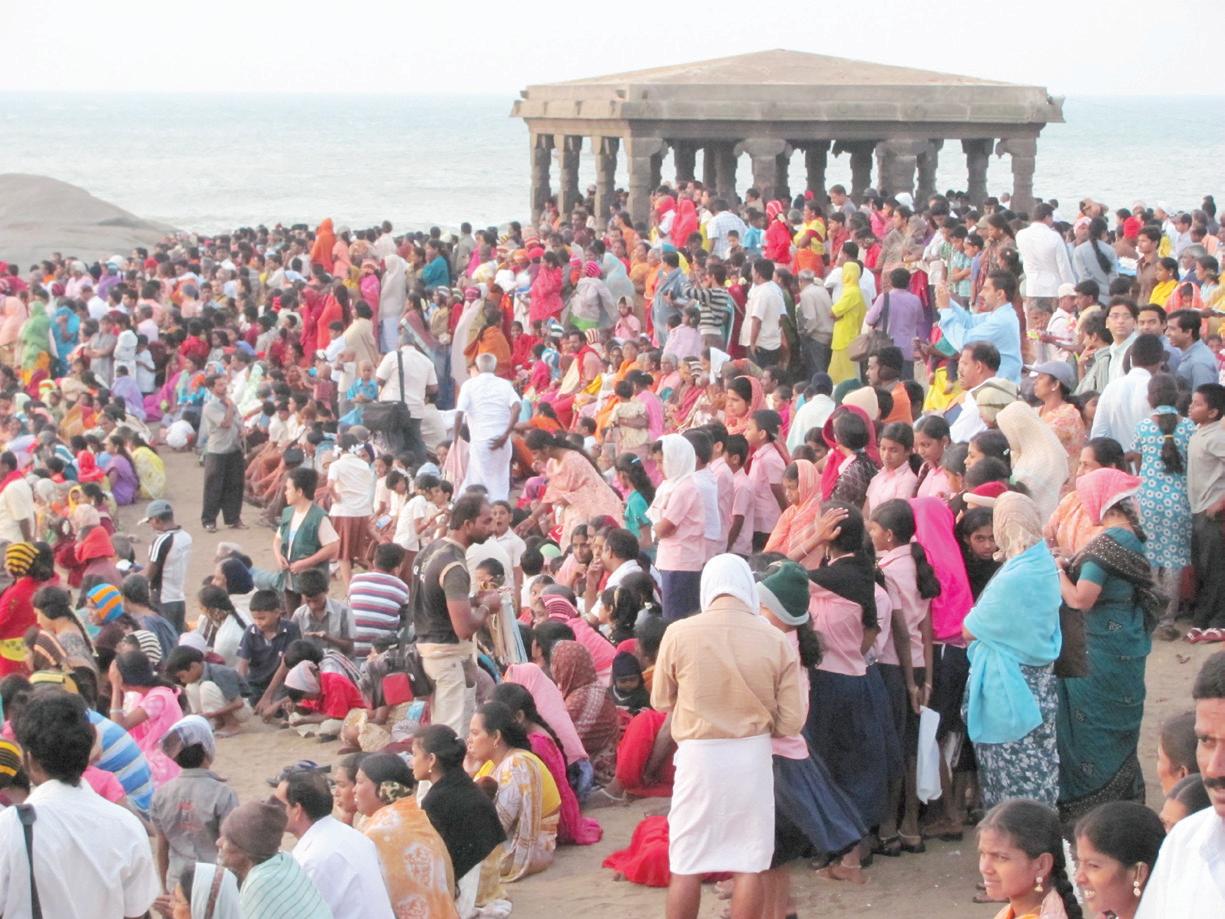
7 minute read
The temple circuit
from 2011-04 Sydney (2)
by Indian Link
BY PETRA O’NEILL
Leaving Chennai, the capital of Tamil Nadu behind, my driver Guna and I made an early start for the temple circuit, heading south along the coastline with its refreshing smell of salt air, the Bay of Bengal on one side and green rice paddy fields on the other. Veering past cows, autorickshaws, overloaded trucks and buses, I was in no hurry to arrive at our destination of Pondicherry, but as is the case for the most pleasurable journeys, time slipped by too fast.
The same road that takes you there also turns off into Fisherman’s Cove, a pleasant seaside settlement of villas and cottages. I could have easily spent the day here relaxing by the poolside and walking along the beach. Instead, I had to do with just a pit stop in the form of a refreshing lime juice at the Vivanta by Taj Hotel.
Astounding architecture and sculpture
Few things in India express the continuous presence of Hindu gods better than the ancient, massive temple complexes found in Tamil Nadu. The so-called ‘temple circuit’ is the main draw for travellers here, as it has been for centuries. We arrived in Mamallapuram, which has some of the oldest stone temples in India. It was already crowded with Indian tourists and juice vendors standing next to carts piled high with fresh green coconuts.
The Five Rathas are an example of Indian rock-cut architecture dating from the 7th century. Created during the reign of King Narasimha Varman I (630-670AD) each temple was carved from one single massive slab of pink granite in the Dravidian style. Named after the Pandavas - Arjuna, Bhima, Yudhishtra, NakulaSahadeva and Draupadi, they are associated with the great epic Mahabharata. Draupadi is shaped like a hut and is dedicated to the goddess Durga. Arjuna has a small portico and carved pillar stones dedicated to Lord Shiva. Nakul and Sahdeva have huge elephant sculptures dedicated to the God of Rain, Lord Indra. The largest Yudhishtra, is also dedicated to Lord Shiva.
The Shore Temple
Perched on a promontory overlooking a sandy beach and the crashing waves of the Bay of Bengal sits the town’s most important architectural site, the Shore Temple, built from 700-728AD during the Pallava dynasty, and considered one of the earliest structural stone temples (that is not rock cut) in southern India, it is a forerunner of the Dravidian style. Two carved layered towers, badly eroded by centuries of exposure to the elements of salt spray and wind, was of a style that had enormous influence on the development of later temples, both in India and southeast Asia. As one of the group of monuments at Mamallapuram, it has also been classified as a World Heritage Site. Vishnu is found reclining inside one shrine, while two others are dedicated to Shiva. A low boundary wall topped by carved bulls surrounds the temple, with lions at the base of the pillars.
Perhaps the most beautiful of the monuments found here is one of the world’s largest bas reliefs known as ‘Arjuna’s Penance’. Dozens of figures from Hindu mythology are carved from the surface of an enormous granite boulder. The central scenes depict a well-known tale from the Mahabharata, that of the revered warrior Arjuna entering the forest to seek the aid of Shiva in a coming battle.
The Chola temples
Heading further south we continued on to Pondicherry, the former French colonial town that is well-deserving of a few days’ stay. When planning this trip, I’d wanted to spend time in
Pondicherry to wander the streets on foot. But a despondent Guna, instead of enjoying a day off, had spent it sitting on the beach waiting for me!
We drove southwest from Pondicherry to reach the first of three great Chola temples, Airavatesvara temple at Darasuram. Built of granite during the reign of Rajaraja II (1146-72AD) there are friezes of dancing figures, elephants and crocodiles, and sculptures of black basalt.
Gangaaikondacholapuram is an absolute joy to behold. Once the capital of the Chola King Rajendra (1012-44AD), the town has all but disappeared. The temple built by him was designed to rival the one built by his father, Rajaraja the Great in Thanjavur. It is over 100 metres long and 40 metres wide with a long colonnaded passage, linking the hall to the shrine. The detailed statues and friezes are as remarkable as the temple’s name with demon statues flanking each doorway.
The drive took us deep into the countryside, past roadside villages. The landscape was flat and drier than what I had imagined.
In Thanjavur, I visited the greatest architectural achievement of the Cholas, who ruled a large part of southern India from this city, the Brihadishwara Temple, or Big Temple. An achievement of King Rajaraja who ruled from 985-1012AD, the impressive scale is apparent as soon as you walk towards it, entering from the outer courtyard towards the interior. The tower above the inner sanctum is the tallest in India and is topped with a massive 80 ton dome of
At the centre of Madurai’s busy commercial area stands what some call the most magnificent temple complex on the subcontinent carved granite. Thousands of statues decorate the tower. There was a surge of visitors rushing to queue before the doors closed to enter the inner sanctum to be blessed by priests and gaze at the large black lingam. A massive brightly painted gopura rose above each of the four entrances to the temple, with 12 tall towers.
Guna then deposited me at the Sangam Hotel, where I said goodbye and joined passengers travelling on the luxury train, the Golden Chariot. While catering primarily for Indian tourists, on this journey there were only 16 passengers onboard including two women from Mumbai, a French photographer, a rather mysterious man from Brazil who said he often travelled under an assumed identity and was undertaking six luxury train journeys across India one after the other, and Aline Dobbie, a writer from Scotland who had grown up in Kolkata.
Dinner was served on antique silverware in a dining car that was coloured in various shades of pink, and I enjoyed a splendid thali. My compartment, also in shades of pink, was spacious and comfortable with a large viewing window to observe the passing scenery, and a row of bathroom amenities for every conceivable purpose.

Magnificence at Madurai
The next morning we arrived in Madurai, one of the most ancient cities in India. It is only fitting that at the centre of its busy commercial area stands what some call the most magnificent temple complex on the subcontinent. It is actually two temples joined, one dedicated to Minakshi and the other to her husband Sundareswarar. Unlike many temples in India, the female god is dominant.
Hundreds of visitors were gathered around the entrance, hoping to get a glimpse of the statue of Sundareswarar. It was not just the majestic Chola temples I had seen that impressed me, but the many Hindu pilgrims so obviously joyful to be here. We returned to the Golden Chariot late that night after a sound and
1. Airavatesvara temple at Darasuram
2. Kanyakumari
3. Shore Temple, Mamallapuram

4. Minakshi Temple, Madurai

5. Five Rathas, Mamallapuram


6. Airavatesvara temple at Darasuram
7. Golden Chariot
8. Golden Chariot Dining Car

9. Golden Chariot thali lunch light show designed for tourists, and dinner at a luxury hotel. As we drove back, I saw many pilgrims at roadside food stalls or preparing for rest.

We continued our train journey overnight to Kanyakumari, where the Bay of Bengal meets the Indian Ocean and the Arabian Sea. The night sky, bright pink and orange was a fitting canopy for the thousands of pilgrims gathered in the city. As the Golden Chariot departed for Kerala, I reflected on the profound significance that the temple circuit has for Hindus, which leaves a traveller moved at being a part of their experience.
Travel notebook
The Temple Circuit in southern India

GETTING THERE
Several airlines will get you from Australia to Chennai. Singapore Airlines flies to Chennai via Singapore, while Malaysia Airlines and Air Asia fly via Kuala Lumpur.
GETTING AROUND
While Indian Railways links Chennai, Tiruchirappalli and Madurai, public transport is less convenient for the temple circuit. For an itinerary that allows you to visit all the sites, I’d recommend hiring a private car and driver. I used Welcome Tours and Travel and found their Innova touring vehicle to be very comfortable. They have many itineraries to choose from or will assist you with designing a tailor-made tour. I thought the cost reasonable.
My driver Guna spoke Tamil and a little English. Welcome Tours and Travel, 150 Mount Road, Chennai Email:agnesh@vsnl.com Website: www.allindiatours.com
You can also travel by luxury train onboard the Golden Chariot or the Southern Splendour, one of two touring itineraries offered. The train makes travel all too easy, and you are transported effortlessly in great style and comfort. A good option if your preference is for a snapshot of the temple circuit. Email: project.director@goldenchariot. org Website: www.goldenchariot.org For those interested in Chola temple architecture, I’d suggest at least a week to more fully appreciate the many treasures to be found here.

ACCOMMODATION
I’d recommend several days in Chennai before heading south. The Vivanta by Taj Connemara is centrally located, with comfortable accommodation and is steeped in history. Email: vivanta.connemara@tajhotels.com Website: wwwvivantabytaj.com
Nearby to Mamallapuram I’d recommend one night at least at the seaside getaway of Fisherman’s Cove at the Vivanta by Taj - Fisherman’s Cove, Covelong. Website: www. vivantabytaj.com
In Pondicherry, I stayed at the Hotel de l’ Orient, a beautifully restored boutique hotel, offering rooms ranging from tiny to vast, filled with an eclectic collection of antiques. Email: orient1804@neemranahotels.com Website: www. neemranahotels.com
In Thanjavur, the Hotel Sangam is perhaps the best choice just outside town. Email: reservation@hotelsangam.com Website: www.hotelsangam.com
In Madurai, for a central location I would recommend the Royal Court Hotel Email:reservations@royalcourtindia.com Website: www.royalcourtindia.com or on a hillside, overlooking the city below, the luxurious Gateway Email: gateway.madurai@ tajhotels.com Website www.thegatewayhotels.com
DINING OUT
Tamil Nadu has one of the most flavoursome regional cuisines in India. The traditional style of cooking, called Chettinad, often mixes curry leaves, tamarind and anise. Hot pepper is used liberally. I had a thali every day, for lunch and dinner.
FURTHER INFORMATION
Tamil Nadu tourism Email: info@tamilnadu-tourism.com
India Tourism, Glasshouse Shopping Complex, Level 5, 135 King Street, Sydney Tel: 02 9221 9555 Email: info@indiatourism.com.au









